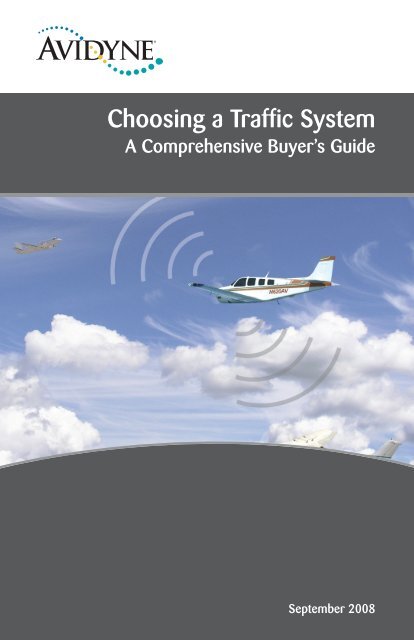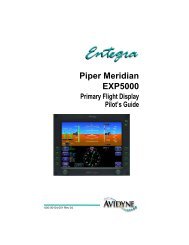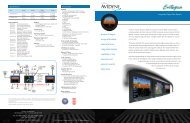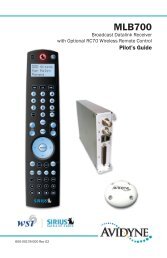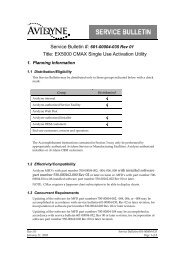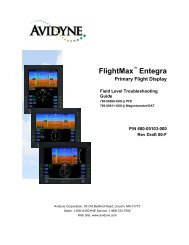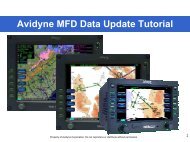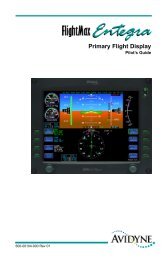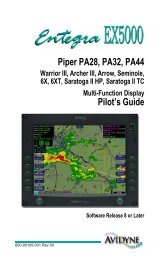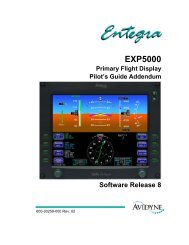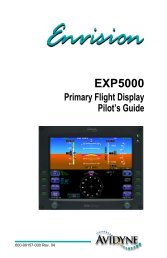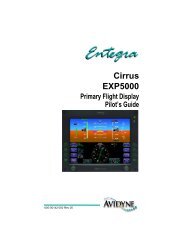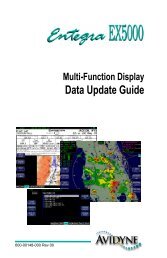Choosing a Traffic System - Avidyne
Choosing a Traffic System - Avidyne
Choosing a Traffic System - Avidyne
You also want an ePaper? Increase the reach of your titles
YUMPU automatically turns print PDFs into web optimized ePapers that Google loves.
®<strong>Choosing</strong> a <strong>Traffic</strong> <strong>System</strong>A Comprehensive Buyer’s GuideSeptember 2008
Table of ContentsIntroduction .......................................................................................1<strong>Choosing</strong> a <strong>Traffic</strong> <strong>System</strong> ..................................................................2See and Avoid Concept .........................................................................2<strong>Traffic</strong> <strong>System</strong>s Defined.........................................................................4About the Dual-Antenna TAS600 ..........................................................6Benefits of dual antennas vs single antenna TAS ....................................8Heads-Up Audible Position Alerting.......................................................9Features of <strong>Avidyne</strong> TAS600 Series........................................................9Ground Mode...............................................................................9Approach Mode............................................................................9Weight on Wheels ......................................................................10Audio Mute................................................................................10N-Number Capability..................................................................10Most Display Options..................................................................10Why install a TAS system on my airplane?...........................................11Dare to Compare - Product Comparisons.........................................12<strong>Traffic</strong> <strong>System</strong> Comparison Chart ...................................................12-13-i-<strong>Choosing</strong> a <strong>Traffic</strong> <strong>System</strong>
Intentionally left blank<strong>Choosing</strong> a <strong>Traffic</strong> <strong>System</strong>-ii-
IntroductionHazard Avoidance is a primary tenet for safety of flight in today’s busy airspaceenvironment and one of the most important safety devices you can add to youraircraft is for avoiding other aircraft. That device is the <strong>Traffic</strong> Advisory <strong>System</strong>(TAS). TAS is a lighter-weight and more-affordable derivative of <strong>Traffic</strong> Alertand Collision Avoidance <strong>System</strong>s (TCAS) which were mandated for all AirTransport-category aircraft and are also found on virtually all Corporate-classturbine aircraft. Seeing and avoiding other aircraft is paramount to safety offlight, and these lower-cost TAS systems provide a second set of eyes in thecockpit to help you fly more safely. This booklet will help you see why<strong>Avidyne</strong>’s TAS600-Series of TAS systems provides the best performance and thebest value for all general aviation aircraft.-1- <strong>Choosing</strong> a <strong>Traffic</strong> <strong>System</strong>
<strong>Choosing</strong> a <strong>Traffic</strong> <strong>System</strong>IntroductionMid-air collisions are a growing concern throughout the world. High air trafficvolume, once only a concern around congested metropolitan airports, iselevating the risk of mid-air collisions. The expansion of regional hubs, alongwith increasing use of helicopters in emergency medical service, electronicnews gathering, fire control, and paramilitary operations including nationalsecurity forces is creating higher risk for mid-air collisions. Critical to safe flightis the accurate and timely pilot awareness of potential threat aircraftinformation. Combining visual and aural alerts provides a higher degree ofaccurate decision making in high workload situations within the modern flightdeck. Dependence on ATC does not guarantee separation. Responsibility forcollision avoidance rests solely with the pilot in command (PIC).Federal Aviation Regulations 91.113 states:When weather conditions permit, regardless of whether anoperation is conducted under instrument or visual flight rules,vigilance shall be maintained by each person operating an aircraft soas to “see and avoid” other aircraft.Understanding the PIC and the Air <strong>Traffic</strong> Controller (ATC) responsibility isalso critical as detailed in Airman’s Information Manual Section 5-5-8 andSection 5-5-10:See and AvoidPilot –1. When meteorological condition permit, regardless of type of flight plan orwhether or not under the control of the radar facility, the pilot isresponsible to see and avoid other traffic, terrain, or obstacles.Controller –1. Provides radar traffic information to radar identified aircraft operatingoutside positive control airspace on a workload permitting basis.2. Issues safety alerts to aircraft under their control if aware the aircraft is atan altitude believed to place the aircraft in unsafe proximity to terrain,obstructions, or other aircraft.<strong>Choosing</strong> a <strong>Traffic</strong> <strong>System</strong> -2-
<strong>Choosing</strong> a <strong>Traffic</strong> <strong>System</strong>Clearly, the PIC is solely responsible for collision avoidance.A recent review* of accident statistical data suggests that the risk of trafficconflicts are actually greatest between a fast moving and a slow movingaircraft. Equally compelling is that in several mid-air accidents, the NTSBdetermined that the probable cause was “the inherent limitations of the seeand avoid concept,” and “underscoring the need for low-cost proximitywarning and conflict detection systems.”1. On average, NASA receives 577 pilot reports of near in-flight collisionseach year.2. On average, there are 15.6 midair collisions each year in US civil aviation.3. Failure to ‘see and avoid’ is cited as the probable cause for 94% of allinflight collisions.4. Advisory Circular 90-48C suggests that the total time required by a pilot toidentify an approaching aircraft, recognize a collision course, decide onaction, execute that action, and allow the aircraft to respond as around12.5 seconds. (<strong>Avidyne</strong>’s TAS600 traffic systems provide a huge benefitwith up to 30 seconds of warning time, more than twice the timerequired).5. Private pilots on VFR flights spend about 50% of their time on outsidetraffic scan during cruise, and only 40% during arrival & departure.6. Referencing an MIT-Lincoln Lab study: VFR pilots given a “TCAS-type”traffic advisory were able to visually acquire traffic 86% of the time,compared with 56% when no traffic advisory was available. And that’s in“severe-clear VFR.” (Of course, the presence of a traffic display allowspilots to “see” transponder-equipped traffic virtually 100% of the time ontheir display).7. Mitigation strategies include having reliable altitude encodingtransponders activated at all times on all aircraft, and affordable andreliable collision avoidance technologies in all general aviation aircraft,as the NTSB recommended in 1987.”It’s clear that today’s on-board traffic avoidance systems -- which have becomemore and more affordable -- provide you with a ‘second set of eyes’ in thecockpit for the added measure of safety you need in today’s busy airspace.*Reference: January 2007 issue of Business & Commercial Aviation titled “Blinded by Seeand Avoid” by Patrick Veillette, Ph.D.-3- <strong>Choosing</strong> a <strong>Traffic</strong> <strong>System</strong>
<strong>Choosing</strong> a <strong>Traffic</strong> <strong>System</strong>Deciphering the many different types of traffic systems can be daunting. Therea five different technologies currently available for traffic detection andsurveillance. Below is a summary of the systems technological differences.<strong>Traffic</strong> Collision Avoidance <strong>System</strong> (TCAS)• TCAS I – Active interrogating system issuing real-time traffic alerts (TA) –Primarily found on Turboprop aircraft and smaller jets• TCAS II – Active interrogating system issuing traffic alerts (TA) andresolution advisories (RA)* Federal Aviation Administration (FAA) mandated in Part 121aircraft – applications usually found in large business jets &commercial aircraft<strong>Traffic</strong> Advisory <strong>System</strong> (TAS)(i.e. <strong>Avidyne</strong> TAS600, Honeywell ® KTA870, L-3 Skywatch ® )• Active interrogating system - Not dependent on “third party interrogation”• Meets FAA TSO-C147 specifications• Provides up to a 30-second warning at up to 1200 knot closure(same as TCAS I)• Interrogates threat aircraft transponders for reply• Provides “real-time” collision alertsPassive <strong>Traffic</strong> Detection Devices• Transponder-based technology• Passive reception – relies on 3rd party interrogation• Receiver only, rarely provides bearing information• Reduced effectiveness outside of radar coverage areas<strong>Traffic</strong> Information Services (TIS)• Utilizes Mode-S transponders only (TIS not available outside continental US)• Datalink information received from select Approach Radar facilities only• Not intended specifically for use as collision avoidance• Information susceptible to data loss due to “line-of-sight” reception• Information delayed 5-15 seconds based on radar interrogation “sweep”• Phase out of TIS-capable Ground Stations already underwayAutomatic dependent Service - Broadcast (ADS-B)• Developed as FAA’s Safe Flight 21 project• Supports air-to-air traffic situational awareness, dependent on GPS todetermine position• Implementation still in its infancy and geographically limited• Technology is still not fully defined regarding 1090MHz versus UATtransceiver hardware. NPRM suggests no mandate until 2020.<strong>Choosing</strong> a <strong>Traffic</strong> <strong>System</strong> -4-
<strong>Choosing</strong> a <strong>Traffic</strong> <strong>System</strong>Three models of TCAS/TAS exist today for air carriers or aircraft owners andoperators. All TCAS/TAS systems are transponder based. If a nearby aircrafthas a transponder that is not functioning or is in the “OFF” position, then theTCAS system will not detect the threat aircraft.Three basic components make up the TCAS/TAS systems. The firstcomponent is the Antenna system; the second is the Processor; and the thirdcomponent is the instrument panel Display.Other <strong>Traffic</strong>Proximity Alert<strong>Traffic</strong> Advisory (TA)TAS and TCAS I systems provide three levels of alert. (Shown here on an MHD).The first level of alert is indicated on the display as an open diamond shape,with the altitude separation indicated between the host and threat aircraft andan arrow indicating if the threat aircraft is climbing, descending, or at the samealtitude. This is referred to as Other <strong>Traffic</strong> (OT). OT is not an immediate threatbut is within the surveillance area and the pilot should be aware of existingtraffic.The second level is the Proximity Alert (PA) which is displayed with the sameinformation as OT, with the exception that the diamond is now a solid shapeon the traffic display. Both OT and PA alerts are typically cyan on a colordisplay or white on a monochromatic display.The third level is the <strong>Traffic</strong> Alert or TA. <strong>Traffic</strong> with a calculated interceptcourse for altitude and direction become a TA. When a TA is encountered, theintruder traffic is indicated as a yellow circle. The pilot is also alerted by anautomated voice alert that says “<strong>Traffic</strong>! <strong>Traffic</strong>!” or <strong>Avidyne</strong>’s Heads-UpAudible Position Alerting announces the threat traffic’s clock position,relative altitude and distance. The alert is based on time to closure rate. Themaximum alert is 30 seconds at a maximum 1200-knot closure, whichcalculates to a ten-mile distance.If the target aircraft is higher than your altitude, its relative altitude will bedisplayed above the target with a plus sign (+02 = 200ft above) and if lower,with a minus sign below the target. A direction arrow next to the targetindicates that the target is either climbing or descending at a rate of 500FPMor greater.-5- <strong>Choosing</strong> a <strong>Traffic</strong> <strong>System</strong>
<strong>Choosing</strong> a <strong>Traffic</strong> <strong>System</strong>TCAS II provides a similar level of alerts as TAS and TCAS I with the additionof Resolution Advisory or RA. When the TCAS II system detects an imminentintercept course, the intruder aircraft is displayed as a red square and the pilotis audibly instructed to “Climb” or “Descend” and visually directed by theRA/IVSI display with the appropriate vertical speed needed to avert a collision.Both aircraft must be equipped with TCAS II systems to experience an RA.The three most popular TAS systems available for general aviation aircraft arethe <strong>Avidyne</strong>’s TAS600 Series, the L3 Skywatch systems, and Honeywell’sKTA-870 system. These systems detect intruder aircraft based on theperformance guidelines of TSO-C147 for traffic advisory systems. Detection isdetermined by using modeling algorithms to calculate relative altitude,distance, and bearing of the intruder aircraft. TAS systems include a mainProcessor and either a top and bottom antenna configuration (TAS600 andKTA-870) or single top-only antenna set-up (Skywatch). It is worth noting thatall TCAS I and TCAS II systems utilize top and bottom antennas for optimumtraffic coverage and minimal shadowing effects of the fuselage.Dual-Antenna TAS600 <strong>System</strong>Safety is the foremost concern when choosing a traffic system for your aircraft.Other concerns include price, functionality, and installation costs. In the nextfew pages we will clearly show you why <strong>Avidyne</strong>’s TAS600 Series are the mostsafe and economical TAS systems on the market today.<strong>Avidyne</strong>’s TAS600 family of <strong>Traffic</strong> Advisory <strong>System</strong>s (TAS) brings affordableactive-interrogation collision avoidance to a wide variety of general aviationaircraft. All TAS600 systems include <strong>Avidyne</strong>-exclusive features and RyanActive Surveillance (RAS) technology.<strong>Choosing</strong> a <strong>Traffic</strong> <strong>System</strong> -6-
<strong>Choosing</strong> a <strong>Traffic</strong> <strong>System</strong><strong>Avidyne</strong>’s TAS600 Series includes three models, designed for the type of aircraftyou fly:TAS620TAS610 TAS6003,500ft3,500ft7,000f t9,900ft19,800ft12nm7nm21nmWith the TAS600 series, you can choose the right traffic system for your aircraft based onoperating altitude and closure rates (range and speed).TAS600–Recommended for entry-level, single-engine piston aircraft, theTAS600 features a 7nm range, a 3,500-foot vertical separation maximum and18,500-foot service ceiling.TAS610–Recommended for mid-performance aircraft and rotorcraft, theTAS610 features a 12nm range, a 3,500-foot vertical separation maximum anda 25,000-foot service ceiling.TAS620–Recommended for high-performance aircraft and rotorcraft, theTAS620 features a 21nm range, a 9,900-foot vertical separation maximum anda 55,000-foot service ceiling.All TAS600 systems offer these additional features:Patented Top and Bottom AntennasLike the dual-antenna architecture of more expensive TCASsystems used in Airliners and Corporate jets, <strong>Avidyne</strong>’s topand bottom directional antennas interrogate and receivereplies from threat aircraft transponders above and belowthe aircraft. This dual-antenna architecture is designed tominimize surveillance interference from your own airframe.The top antenna provides directional surveillance to the frontand aft on the aircraft. The bottom antenna provides directional surveillance tothe left and right of the aircraft.This dual-antenna architecture provides greateraccuracy for range and bearing resolution of intruder aircraft.-7- <strong>Choosing</strong> a <strong>Traffic</strong> <strong>System</strong>
<strong>Choosing</strong> a <strong>Traffic</strong> <strong>System</strong>Single-antenna systemsThe interrogation signals from single-antenna systems may not always receivereplies due to airframe shadowing, or they can miss replies from aircraftbeneath the host aircraft.Patented Top and Bottom Antennas<strong>Avidyne</strong>’s TAS600 sends out interrogation pulses and listens for replies fromother aircraft 360° around the host aircraft.<strong>Choosing</strong> a <strong>Traffic</strong> <strong>System</strong> -8-
<strong>Choosing</strong> a <strong>Traffic</strong> <strong>System</strong><strong>Avidyne</strong>’s Heads-Up Audible Position Alerting Safety is not limited to visual interpretation, which is why Heads-Up AudiblePosition Alerting is incorporated into all TAS600 Series systems. Heads-UpAudible Position Alerting annunciates the threat alert, clock face position, andrelative vertical position and distance of any threat aircraft within thesurveillance envelope, thus reducing visual overload. With Heads Up AudiblePosition Alerting, the TAS600 clearly alerts the pilot to an imminent threat:TRAFFIC! TWO O’CLOCK! HIGH! THREE MILES!The TAS600 series eliminates the added step of acquiring the intruder aircrafton a display and then visually locating the threat. With the TAS600, you cannow simply, HEAR AND ACQUIRE.Active InterrogationAll TAS600 systems search the sky in real-time in any radar or non-radarenvironment. The interrogation of ATC, military radar, and other activecollision avoidance systems is continuously sent up to 56 times per second bythe TAS600 and can receive replies from Mode A, C, or S transponders.The TAS600, TAS610, and TAS620 are designed to meet the specific needs ofeach class of aircraft, providing a full 30-second decision time at a closure rateof up to 1200 knots. TAS600 series traffic systems interrogate transpondersfrom nearby aircraft within their respective coverage volume, and provide awarning to the flight crew when the calculated time to closest approach (CPA)of any intruder and the protected area around the aircraft reaches the30-second threshold.<strong>Avidyne</strong> TAS600-Series Features & Functions:Ground ModeGround Mode enables the system to ignore traffic on the ground and muteaudio announcement while displaying traffic more than two hundred feet abovethe ground eliminating “nuisance alerts.” This feature is important as theaircraft taxis out, especially at uncontrolled airports. The “Weight on Wheels”mode will automatically enable and disable Ground Mode.Approach ModeThe Approach Mode, when engaged, permits the TAS600 Series to ignoretraffic on the ground during the approach phase of a flight eliminating“nuisance alerts.” At times the pilot may desire to “see” traffic duringapproach, with this in mind, the system was engineered as a pilot selectableoption.-9- <strong>Choosing</strong> a <strong>Traffic</strong> <strong>System</strong>
<strong>Choosing</strong> a <strong>Traffic</strong> <strong>System</strong>Weight on WheelsThis is a discrete input which automatically switches the TAS600 system intoGround Mode upon landing, minimizing any distraction from ground traffic.<strong>Traffic</strong> above the host aircraft is still shown on the multifunction display,without audio warnings. This also allows for continued situational awarenesswhen preparing for departure.Audio Yoke-Mounted Mute and Volume ControlThe TAS600 Series is the only TAS system available with an audio volumecontrol enabling the announcement to be heard by the pilot and crew but notnecessarily heard by passengers. Also available is a yoke-mounted mute buttonwhich allows the system to be muted when needed. If another <strong>Traffic</strong> Alert(TA) is detected, the TAS600 system will automatically disengage the mute andannounce the threat and updated intruder position.N-Number CapabilityMode S transponder-equipped aircraft have the ability to transmit theirN-number, which can be decoded by the TAS600 system. This number can beviewed on compatible multifunction displays when interfaced to the TAS600via its RS232 data bus output.Most Display OptionsThe TAS600 Series provides industry-standard ARINC 429 and RS232 displayoutputs and has the most display options available for TAS systems.With interfaces to the displays of over 15 popular display manufacturers,including <strong>Avidyne</strong>’s Entegra, EX500 and EX5000, the Garmin GNS430/530and G1000, it’s a pretty safe bet that the TAS600 can connect to your displaywith ease.<strong>Choosing</strong> a <strong>Traffic</strong> <strong>System</strong> -10-
<strong>Choosing</strong> a <strong>Traffic</strong> <strong>System</strong>Why should I install a traffic system on my airplane?The most feared of all flying incidents is the mid-air collision. Even when weare vigilant in our “See and Avoid” technique, we fear what we can’t control;the occurrence of “the other guy” who might not be as diligent as us. Perhapsthe fear is out of proportion to the actual threat, but nonetheless it is regardedone of deadliest flying hazards.It’s obvious that mid-airs happen when they are least expected. The pilot’sresponsibility is to visually scan for traffic, and even the best set of eyes canmiss a fast-moving approaching aircraft. This presents a real need for a trafficadvisory system. Throughout the years, statistics have proven that thesesystems have decreased the total number of mid-air collisions.Dare to CompareAircraft owners now have the advantage of installing the most technologicallyadvanced traffic advisory system at a very affordable cost. <strong>Avidyne</strong> has designedthe TAS600 Series with safety as the predominant feature. And starting at only$9,990, the TAS600 is the most affordable active TAS system in the generalaviation marketplace.Competitive traffic systems start at a minimum price of $15,000 with lessfeatures and surveillance capabilities. We encourage you to compare features,functions, technology and value. Consider the TAS600 Series for installationin your aircraft.With <strong>Avidyne</strong>’s MHAS Package Pricing, the savings can be considerable whenthe TAS600 system is bundled with an EX500 or EX5000 MFD and anMLB700 Broadcast Datalink Receiver. Review the full competitive matrix for<strong>Traffic</strong>, MFDs, and Datalink on the following pages to see what we mean.-11- <strong>Choosing</strong> a <strong>Traffic</strong> <strong>System</strong>
<strong>Choosing</strong> a <strong>Traffic</strong> <strong>System</strong>Feature TAS600 TAS610 TAS620Suggested List Price $9,990 $14,990 $20,990ActiveInterrogationYes Yes YesAudible Range,Bearing, Altitude,and Altitude TrendCall-outsYesHeads UpStandardYesHeads UpStandardYesHeads UpStandardTop & BottomAntennasYes Yes YesRange 7nm 12nm 21nmVertical Range ±3,500 ±3,500 ±9,900Service Ceiling 18,500 25,000 55,000Ground Mode Yes Yes YesWeight on Wheels Yes Yes YesYoke Mount Mute Yes Yes YesN-NumberIntruder DisplayNumber ofTargets TrackedNumber ofTargets DisplayedYes Yes Yes50 50 509 9 9<strong>System</strong> Weight 9.29 lbs 9.29 lbs 9.29 lbsProcessorDimensionsW 3.10”H 7.25”D 11.675”W 3.10”H 7.25”D 11.675”W 3.10”H 7.25”D 11.675”<strong>Choosing</strong> a <strong>Traffic</strong> <strong>System</strong> -12-
<strong>Choosing</strong> a <strong>Traffic</strong> <strong>System</strong>FeatureSkywatch497SkywatchHPHoneywellKTA-870Suggested ListPriceActiveInterrogationAudible Range,Bearing, Altitude,and AltitudeTrend Call-outsTop & BottomAntennas$18,890 $25,980 $24,690Yes Yes YesYesOptionalVIPYesOptionalVIPNoNo No YesRange 11nm 35nm 40nmVertical Range ±9,900 ±9,900 ±8,700Service Ceiling 55,000 55,000 55,000Ground Mode Yes Yes YesWeight onWheelsYes Yes YesYoke Mount Mute No No NoN-NumberIntruder DisplayNumber ofTargets TrackedNumber ofTargets DisplayedNo No No30 35 6010 10 60<strong>System</strong> Weight 13.54 lbs 13.54 lbs 15.20 lbsProcessorDimensionsW 12.52”H 3.56”D 7.62”W 12.52”H 3.56”D 7.62”W 4.5”H 7.0”D 13.8”Comparison data based on mfg. website data and is subject to change without notice.-13- <strong>Choosing</strong> a <strong>Traffic</strong> <strong>System</strong>
<strong>Choosing</strong> a <strong>Traffic</strong> <strong>System</strong> -14-
International customers please contact:DAC International, Inc.6702 McNeil Dr.Austin, TX 78729Telephone: 512-331-5323Email: <strong>Avidyne</strong>@dacint.comwww.dacint.com®55 Old Bedford RoadLincoln, MA 01773Telephone: 781-402-7400 Toll Free: 800-AVIDYNE (800-284-3963)FAX:781-402-7599www.avidyne.comAV679 Rev 02 9/08 1000©2008 <strong>Avidyne</strong> Corporation All Rights Reserved.Other company and product names may be trademarksof the respective companies with which they are associated.


